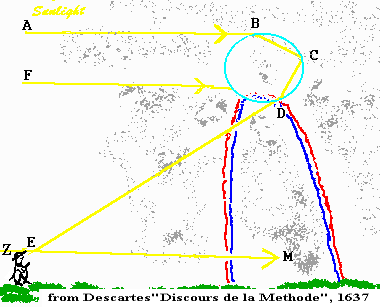Men, you are with me on this; she has a man who can make a rainbow for her any time she wants - and will. That's a higher order of romantic, I think you will agree. Plus, I have to defend all rainbow-making men and note that because my rainbow is a special distribution of colors whose reference point is her eyes, no one else will ever see it. Is it literally for her eyes only.
And these aren't hot dogs we are talking about. Seeing a rainbow made is not going to make them terrible, they are still pretty cool. I see a rainbow every day when I water my lawn, because I want to see a rainbow and so I do it on purpose, and it is neat every single time.
I'm not special, though. No less an esteemed scientist-philosopher than Rene Descartes was making rainbows for his wife centuries ago, but he could do it with a single drop of water. The Descarte (rainbow) ray is named after him because he beat me to it by almost 375 years.
Descarte's Discours de la Methode tells you all you need to know now, but the discovery was not trivial. He used the scientific method to calculate that light entering a drop of water from behind him and deviating 42 degrees could make this happen every single time.

Credit: University Corporation for Atmospheric Research. Oh, and Descartes.
He not only discovered the angle but deduced how the shape of the water drops and the arc of the minimum deviation made the 'arc' rainbow instead of a whole raincircle: "I took my pen and made an accurate calculation of the paths of the rays which fall on the different points of a globe of water to determine at which angles, after two refractions and one or two reflections they will come to the eye, and I then found that after one reflection and two refractions there are many more rays which can be seen at an angle of from forty-one to forty-two degrees than at any smaller angle; and that there are none which can be seen at a larger angle".
For a rainbow, the colors are always the same order because he found that red light bends the least, exiting his drop at a 42 degree angle, and violet light bends the most, exiting at a 40 degree angle. ROYGBIV is an acronym, if that helps. If you want to improve your chances/decrease your work, use a hose because you can control the water and try in the morning or later afternoon. Rainbows at noon are tough because the center of the rainbow is opposite the Sun, so if it is right above you, it's more work.
What I can't do easily is make two rainbows happen at once. I just said the order of colors is always the same, but that is if you only see one rainbow. If you see two, the 'primary' rainbow is produced by one internal reflection and a secondary rainbow happens when there are two internal reflections and the sun's rays exit the water drops at an angle of 50 degrees° instead of 42°degrees. So the secondary rainbow has its colors reversed, because, as one example, the blue light is exiting at an angle of 53 degrees°.
One thing I have yet to create; a lunar rainbow. But we'll be married for another 50 years or whatever, so I have time.
Rainbow experiment for kids: Sesame Street is as good as it can get for this one.
Rainbow experiment for adults, using a glass of beer - I recommend Pabst Blue Ribbon, but I pretty much recommend that for everything.
Note:
(1) And yet if I found a pot o' gold at the end of one, she wouldn't mind listening to my explanation at all. Go figure.





Comments